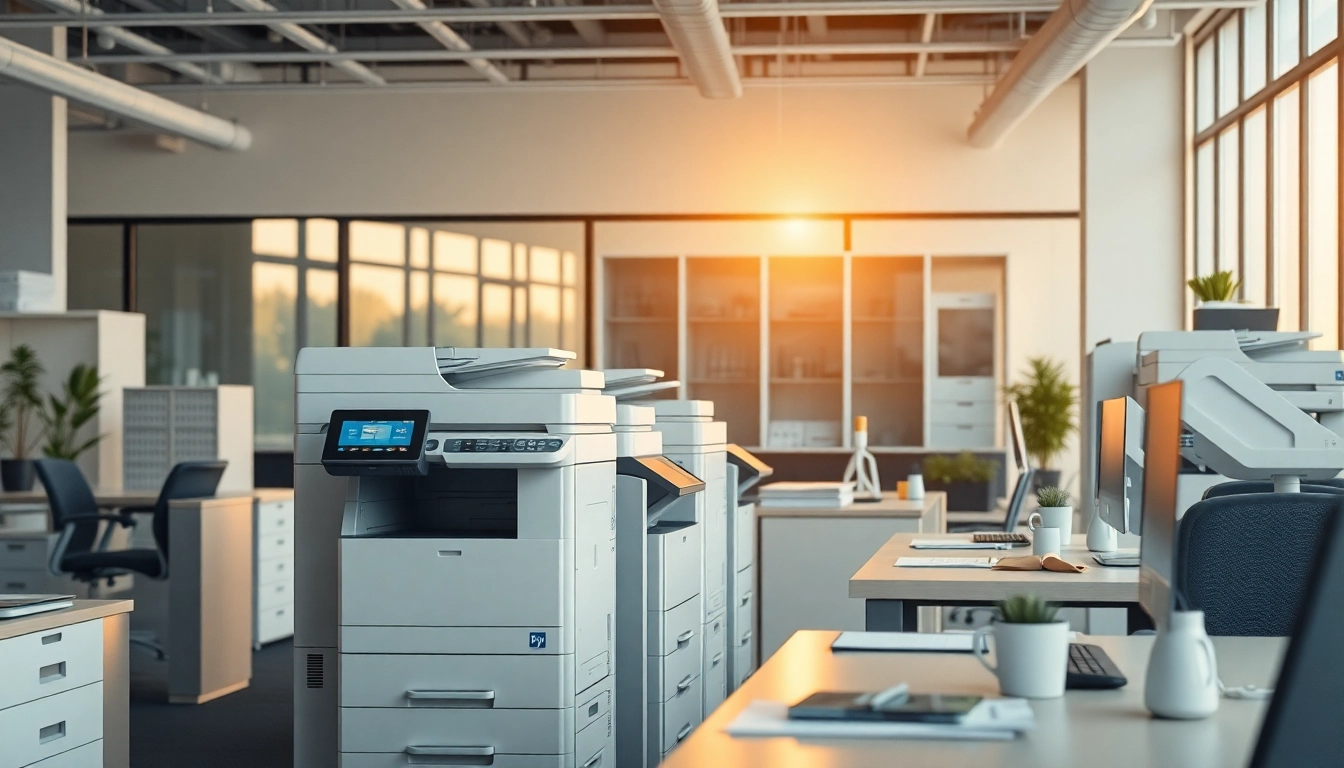Understanding Office Machines
Introduction to Different Types of Office Machines
In today’s fast-paced work environment, the efficiency and functionality of office machines play a crucial role in organizational effectiveness. From photocopiers to multifunction printers, understanding the different types of office machines is essential for optimizing workflow and enhancing productivity. Common office machines include:
- Photocopiers: Essential for duplicating documents quickly and efficiently.
- Printers: Used for producing hard copies of documents, photos, and other materials.
- Scanners: Converts physical documents into digital format for storage and sharing.
- Fax Machines: Though less common now, they are still used for sending documents over phone lines.
- Binders and Trimmers: Useful for document management and finishing touches on reports.
- Label Makers: Help in organizing workspace and materials through effective labeling.
Each of these machines has its unique functionalities that cater to specific business needs, making it essential to choose wisely based on your office’s requirements.
Key Features of Modern Office Machines
Modern office machines come equipped with advanced features that significantly improve their efficiency. Key features to consider include:
- Connectivity: Wi-Fi and Bluetooth connectivity allow for seamless printing and scanning from various devices including smartphones and tablets.
- Multifunctionality: Many machines combine multiple functions (printing, scanning, copying, and faxing) into a single device, saving space and reducing costs.
- Energy Efficiency: Newer models are designed to consume less power and reduce environmental impact, offering sleep modes and energy-saving settings.
- User-Friendly Interfaces: Touchscreen displays simplify navigation and functionality, allowing users to access various features easily.
- Cloud Integration: Modern office machines can directly print or scan to cloud services, enhancing document management efficiency.
Incorporating machines with these features into your office can enhance user experience and operational efficiency.
The Role of Office Machines in Workplace Productivity
Office machines significantly impact workplace productivity. They streamline various processes and facilitate quick communication among staff. Here’s how:
- Time Savings: Machines like printers and scanners reduce the time spent on administrative tasks, allowing employees to focus on core business activities.
- Improved Accuracy: Automated machines minimize human error, particularly in data entry and document management.
- Enhanced Collaboration: By enabling quick sharing of documents, machines improve teamwork and collaboration across departments.
- Cost-Effectiveness: Efficient machines reduce the cost associated with paper, ink, and labor over time.
Therefore, investing in the right office machines can yield substantial returns in productivity and efficiency.
Selecting the Right Office Machines for Your Business
Assessing Your Office Needs and Space
To select the best office machines for your business, begin by assessing your specific needs. Consider the following:
- Office Size: Evaluate the layout and space available for machines. Smaller offices may require compact multifunction printers.
- Volume of Use: Estimate how frequently machines will be used. High-traffic offices require robust models capable of handling larger volumes.
- Employee Count: Consider how many employees will need access to the machines. This will inform whether you need a single multifunction device or multiple machines to cater to various departments.
- Specific Functions: Determine necessary functions (e.g., color printing, high-resolution scanning) that align with your business operations.
By thoroughly assessing your office environment and needs, you can make informed decisions regarding which machines to invest in.
Comparing Popular Office Machines
Once you have a grasp of your requirements, the next step is to compare popular office machines available in the market. Consider the following popular categories:
- Laser Printers vs. Inkjet Printers: Laser printers are ideal for high volume printing with lower cost per page, while inkjet printers offer superior photo quality.
- All-in-One Printers: These machines combine printing, scanning, and copying, making them suitable for small to medium-sized businesses.
- Digital Copiers: Great for businesses requiring high-quality document reproduction.
- Commercial Printers: Heavy-duty machines that can manage high output and are often used in large enterprises.
Evaluate the specifications, pricing, and support services of each option before making a decision.
Renting vs. Buying Office Machines
Deciding between renting and buying office machines involves weighing the pros and cons of both options:
- Renting: This option provides flexibility and allows you to upgrade frequently. It’s particularly advantageous for businesses with fluctuating needs or cash flow constraints.
- Buying: While a larger initial investment, ownership reduces long-term costs and eliminates ongoing rental fees. It’s ideal for stable businesses with consistent needs.
Consider a cost-benefit analysis based on your specific business model.
Integrating Office Machines into Your Workflow
Seamless Setup and Installation
Integrating new office machines into your workflow begins with proper setup and installation. Here are essential steps:
- Read the Manual: Understanding the user manual is crucial for correct installation and operation.
- Connect to Network: Ensure machines are properly connected to your office network for optimal functionality.
- Test Functions: Run test prints, scans, and copies to confirm that all features work as intended.
- Configure Settings: Tailor settings (e.g., print quality, color settings) to meet your business’s specific needs.
Proper installation contributes significantly to maximizing the potential of your office machines.
Training Staff on New Office Machines
It’s imperative to train staff on how to use the new machines effectively. Training programs might include:
- Hands-On Sessions: Allow employees to interact with the machine, guided by an expert.
- Documentation Reference: Provide access to user manuals and internal documents on best practices.
- Regular Workshops: Host periodic workshops to refresh skills and introduce any new functionalities.
Well-trained staff can reduce operational bottlenecks and enhance productivity through efficient machine use.
Best Practices for Utilizing Office Machines Effectively
To get the most out of your office machines, follow these best practices:
- Routine Maintenance: Schedule regular maintenance checks to keep machines running smoothly and to prevent breakdowns.
- Monitor Usage: Track the usage of machines to understand demand and identify opportunities for optimization.
- Encourage Feedback: Solicit employee input on machine performance and any challenges they may face in using them.
By instilling a culture of care and regular feedback, organizations can maximize the lifespan and efficiency of their office machines.
Maintenance and Troubleshooting of Office Machines
Routine Maintenance Checks
Routine maintenance is crucial for extending the life of office machines. Consider these routine checks:
- Cleansing: Regularly clean dust and debris from machines to enhance performance.
- Check Ink/Toner Levels: Monitor levels to avoid sudden disruptions due to running out during print jobs.
- Update Software: Keep driver and application software updated to ensure compatibility and security.
Implementing a scheduled maintenance check can prevent unexpected breakdowns and repair costs.
Common Issues and How to Solve Them
Despite careful maintenance, office machines might encounter issues. Common problems include:
- Paper Jams: Regular checks and proper paper loading techniques help mitigate this issue.
- Print Quality Issues: These can often be fixed by cleaning printer heads and ensuring correct ink levels.
- Connectivity Problems: Confirm that the machine is connected to the correct network and that drivers are up-to-date.
Understanding how to troubleshoot these common issues can save time and maintain office effectiveness.
When to Call for Professional Help
Recognizing when to call for professional help is crucial to maintaining productivity. Scenarios include:
- Hardware Issues: If machines make unusual noises or fail to operate despite troubleshooting efforts.
- Software Glitches: When encountering unexplained functional discrepancies that disrupt usability.
- Regular Service Checks: Hiring professionals for regular servicing can prevent long-term issues.
A proactive approach to maintenance allows businesses to resolve problems before they escalate into significant disruptions.
The Future of Office Machines in Business
Innovations on the Horizon for Office Machines
The future of office machines is promising, with innovations continuously emerging that aim to enhance functionality and usability. Expectations include:
- AI Integration: Artificial intelligence is expected to power more intelligent machines capable of self-diagnosis and adaptive settings.
- Enhanced Mobile Compatibility: Greater connectivity with mobile devices, allowing users to operate machines from anywhere.
- Sustainability Innovations: Advances in technology designed to minimize environmental impacts through improved energy efficiency.
Staying informed about these innovations will allow businesses to incorporate cutting-edge tools for improved efficiency.
Impact of Technology on Office Machine Efficiency
Advancements in technology continue to enhance the efficiency of office machines. Factors include:
- Cloud Services: Integration with cloud services allows for easier access to documents and files from anywhere.
- Automation Features: Machines now come equipped with automated workflows that save time and reduce manual labor.
- Data Analytics: Built-in analytics tools provide insights into machine usage patterns, promoting informed decision-making.
These technological improvements lead to reductions in costs and increased productivity across the board.
Preparing Your Office for Emerging Trends in Office Machines
As new trends emerge, offices must proactively prepare by:
- Staff Training: Continuously train staff to adapt to changes in technology and maximize new features.
- Updating Infrastructure: Invest in better networking and power solutions to support advanced machines.
- Resource Allocation: Allocate funds for future equipment that incorporates emerging technologies.
By maintaining a forward-thinking approach, businesses can harness the power of new office machines and stay competitive.


